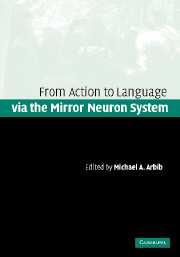Book contents
- Frontmatter
- Contents
- List of contributors
- Preface
- Part I Two perspectives
- Part II Brain, evolution, and comparative analysis
- Part III Dynamic systems in action and language
- Part IV From mirror system to syntax and Theory of Mind
- Part V Development of action and language
- 12 The development of grasping and the mirror system
- 13 Development of goal-directed imitation, object manipulation, and language in humans and robots
- 14 Assisted imitation: affordances, effectivities, and the mirror system in early language development
- 15 Implications of mirror neurons for the ontogeny and phylogeny of cultural processes: the examples of tools and language
- Index
- References
12 - The development of grasping and the mirror system
Published online by Cambridge University Press: 01 September 2009
- Frontmatter
- Contents
- List of contributors
- Preface
- Part I Two perspectives
- Part II Brain, evolution, and comparative analysis
- Part III Dynamic systems in action and language
- Part IV From mirror system to syntax and Theory of Mind
- Part V Development of action and language
- 12 The development of grasping and the mirror system
- 13 Development of goal-directed imitation, object manipulation, and language in humans and robots
- 14 Assisted imitation: affordances, effectivities, and the mirror system in early language development
- 15 Implications of mirror neurons for the ontogeny and phylogeny of cultural processes: the examples of tools and language
- Index
- References
Summary
Introduction: a mirror system perspective on grasp development
Neonates and young infants are innately compelled to move their arms, the range of possible spontaneous movements being biologically constrained by anatomy, environmental forces, and social opportunity. Over the first 9 postnatal months, reaching movements are transformed as infants establish an array of goal-directed behaviors, master basic sensorimotor skills to act on those goals, and acquire sufficient knowledge of interesting objects to preplan goal-directed grasping. In monkeys, it appears that the neural circuit for control of grasping also functions to understand the manual actions of other primates and humans (Arbib, Chapter 1, this volume). Within the grasp circuitry, “mirror neuron” activity encodes both the manual actions executed by the monkey and the observed goal-directed actions of others. Recent imaging studies on humans indicate that a mirror neuron network may exist in humans linking observation and execution functions. However, the link between grasp development and mirror system development is widely unexplored. To address this, we will build models based both on behavioral data concerning the course of development of reaching in human infants and on neurophysiological data concerning mirror neurons and related circuitry in macaque monkeys.
In humans, the foundation for reaching may begin as early as 10–15 weeks of fetal development when fetuses make hand contact with the face and exhibit preferential sucking of the right thumb (de Vries et al., 1982; Hepper et al., 1991).
- Type
- Chapter
- Information
- Action to Language via the Mirror Neuron System , pp. 397 - 423Publisher: Cambridge University PressPrint publication year: 2006
References
- 6
- Cited by



